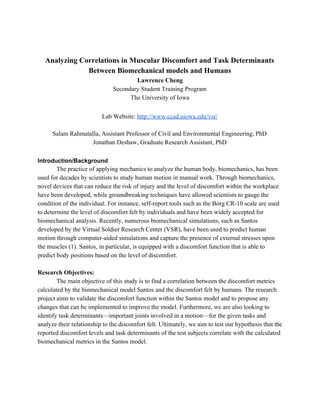More Related Content
Similar to EngineeringResearchPaper
Similar to EngineeringResearchPaper (20)
EngineeringResearchPaper
- 1.
Analyzing Correlations in Muscular Discomfort and Task Determinants
Between Biomechanical models and Humans
Lawrence Cheng
Secondary Student Training Program
The University of Iowa
Lab Website: http://www.ccad.uiowa.edu/vsr/
Salam Rahmatalla, Assistant Professor of Civil and Environmental Engineering, PhD
Jonathan Deshaw, Graduate Research Assistant, PhD
Introduction/Background
The practice of applying mechanics to analyze the human body, biomechanics, has been
used for decades by scientists to study human motion in manual work. Through biomechanics,
novel devices that can reduce the risk of injury and the level of discomfort within the workplace
have been developed, while groundbreaking techniques have allowed scientists to gauge the
condition of the individual. For instance, selfreport tools such as the Borg CR10 scale are used
to determine the level of discomfort felt by individuals and have been widely accepted for
biomechanical analysis. Recently, numerous biomechanical simulations, such as Santos
developed by the Virtual Soldier Research Center (VSR), have been used to predict human
motion through computeraided simulations and capture the presence of external stresses upon
the muscles (1). Santos, in particular, is equipped with a discomfort function that is able to
predict body positions based on the level of discomfort.
Research Objectives:
The main objective of this study is to find a correlation between the discomfort metrics
calculated by the biomechanical model Santos and the discomfort felt by humans. The research
project aims to validate the discomfort function within the Santos model and to propose any
changes that can be implemented to improve the model. Furthermore, we are also looking to
identify task determinants—important joints involved in a motion—for the given tasks and
analyze their relationship to the discomfort felt. Ultimately, we aim to test our hypothesis that the
reported discomfort levels and task determinants of the test subjects correlate with the calculated
biomechanical metrics in the Santos model.
- 2. Method:
The research study was heavily designed around the inertial sensor suit developed by
Xsens, which was used during the study to record the motions of the human test subject. We
used a healthy male test subject with no history of musculoskeletal injury and designed 4 tasks
for him to complete in the inertial suit. The tasks included a ladder climb, large wall climb, small
wall climb, and a modified large wall climb. In order to validate the Santos discomfort function,
we included a subjective response portion in which subjects would rate their overall discomfort
using the Borg CR10 scale and list any joints of interest at a certain moment during the task.
Finally, the subjective responses were graphed, normalized, and compared to the predicted
Santos model to determine any correlations.
Results:
The results for the research study show that the correlation coefficient R2
is 0.7537 for
the trendline between the predicted Santos discomfort and the actual human discomfort for the
large wall, small wall, and large wall modified when the outliers are taken out. We also
discovered that the Santos discomfort function would rate the discomfort for a lyingdown
position very high even though the test subject rated the discomfort of the position near 0,
presenting outliers within our data set. With the outliers, the R2
became 0.3149, but without the
outliers it went back to 0.75. However, with the ladder climb results included within the data set,
the correlation went down to 0.3888. Furthermore, using the changes in joint angles we found
that the wrist abduction/adduction and the shoulder abduction/adduction were the task
determinants for the Large Wall, Small Wall, and Large Wall Alternative. There was also wrist
flexion/extension for the large wall alternative and shoulder flexion/extension for ladder climb.
Conclusions/Implications:
We conclude that based on the R2
value of 0.7537, there is a fairly strong, positive
correlation between the Santos discomfort function and the human discomfort. In addition, our
results suggest that changes may be made to the Santos model for measuring the discomfort of
the lyingdown position, as the predicted discomfort was very high when the subjective response
was low. The implications of this research project may provide leads for places on Santos that
VSR may be able to look into in more depth, perhaps with multiple test subjects, as this project
only included one. Although the task determinants we found gave estimations to which particular
joints were in the greatest discomfort, the Santos discomfort function could be further improved
by equipping the model with the ability to calculate the quantitative discomfort level for
individual joints, rather than just an overall discomfort.

